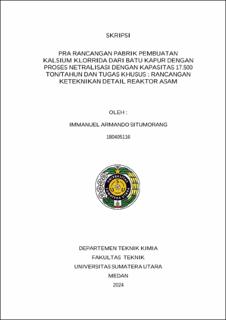| dc.description.abstract | Calcium chloride is an inorganic compound with the chemical formula CaCl2. It is available in the form of flakes containing 77-80% calcium chloride or granules containing 94% calcium chloride. In liquid form, it contains 30-42% calcium chloride per liter of solution. Calcium chloride has various uses, including as a drying agent, ice melter, a source of calcium ions, an additive in the food industry, and in the medical field.
In the pre-design of this factory, limestone is used as the main raw material, where limestone contains 95% calcium carbonate that can be utilized to produce calcium chloride. The process involves mixing limestone and hydrochloric acid (HCl). Limestone is crushed using a crusher (C-101), then eggshells are ground using a ball mill (BM-101) and sieved with a 200-mesh screen (S-101). The resulting material is fed into the acid reactor (R-101), where limestone is stirred while adding hydrochloric acid solution at 60°C. The reaction product is then fed into the neutralization reactor (RN-101) to separate magnesium and neutralize the remaining acid at a reaction temperature of 85°C. The output from the neutralization reactor is fed into the evaporator (E-101), followed by the crystallizer (CR-101) and then the centrifuge (CF-101). It is then transported to the rotary dryer (RD-101), and before heading to the storage warehouse, it is cooled using a rotary cooler (RC-101).
The pre-design of the calcium chloride plant using limestone as a raw material is planned to produce with a capacity of 17,500 tons per year and operate for 330 days in a year. The factory's planned location is in Tuban, specifically in the Widang District, East Java Province, Indonesia. The land area required for the factory is 13,204 m2. The utility water needs for the factory will be supplied from the Asahan River at a rate of 9,944.557 kg/hour. The planned organizational structure of the company is a Limited Liability Company (PT) with a total of 221 employees.
The economic analysis results are as follows :
1.
Capital Investment (CI) : Rp 272.886.201.495,030
2.
Total Cost (TC) : Rp 232.581.519.670,919
3.
Profit Margin (PM) : 42,579 %
4.
Break Event Point (BEP) : 43,079 %
5.
Return On Investment (ROI) : 30,824 %
6.
Pay Out Time (POT) : 3,244 tahun
7.
Return On Network (RON) : 51,373 %
8.
Internal Rate of Return (IRR) : 27,906 %
Based on the economic analysis, it can be concluded that the "Calcium Chloride Manufacturing Plant from Limestone with a capacity of 17,500 tons/year" is feasible for establishment. | en_US |


